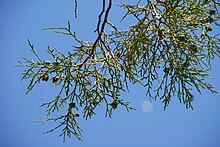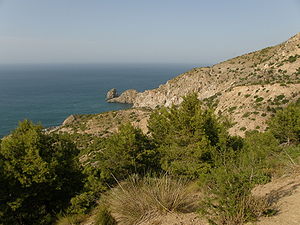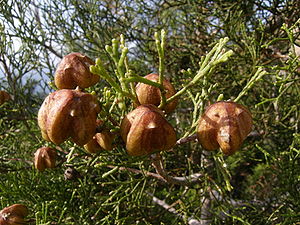| Tetraclinis | |
|---|---|

| |
| Conservation status | |
 Least Concern (IUCN 3.1) | |
| Scientific classification | |
| Kingdom: | Plantae |
| Clade: | Tracheophytes |
| Clade: | Gymnospermae |
| Division: | Pinophyta |
| Class: | Pinopsida |
| Order: | Cupressales |
| Family: | Cupressaceae |
| Subfamily: | Cupressoideae |
| Genus: | Tetraclinis Mast. |
| Species: | T. articulata |
| Binomial name | |
| Tetraclinis articulata (Vahl) Mast. | |

| |
| Natural range | |
| Synonyms | |
| |

Tetraclinis (also called arar, araar or Sictus tree) is a genus of evergreen coniferous trees in the cypress family Cupressaceae, containing only one species, Tetraclinis articulata, also known as Thuja articulata, sandarac, sandarac tree or Barbary thuja, endemic to the western Mediterranean region.
Distribution and habitat
It is native to northwestern Africa in the Atlas Mountains of Morocco, Algeria, and Tunisia, with two small outlying populations on Malta, and near Cartagena in southeast Spain in Europe. It grows at relatively low altitudes in a hot, dry subtropical Mediterranean climate.
Taxonomy
Its closest relatives are Platycladus, Microbiota, and Calocedrus, with the closest resemblance to the latter. In older texts, it was sometimes treated in Thuja or Callitris, but it is less closely related to those genera.
Description

It is a small, slow-growing tree, to 6–15 m (rarely 20 m) tall and 0.5 m (rarely 1 m) trunk diameter, often with two or more trunks from the base. The foliage forms in open sprays with scale-like leaves 1–8 mm long and 1–1.5 mm broad; the leaves are arranged in opposite decussate pairs, with the successive pairs closely then distantly spaced, so forming apparent whorls of four. The cones are 10–15 mm long, green ripening brown in about 8 months from pollination, and have four thick scales arranged in two opposite pairs. The seeds are 5–7 mm long and 2 mm broad, with a 3–4 mm broad papery wing on each side.
It is one of only a small number of conifers able to coppice (regrow by sprouting from stumps), an adaptation to survive wildfire and moderate levels of browsing by animals. Old trees that have sprouted repeatedly over a long period form large burls at the base, known as lupias.
Uses and symbolism
It is the national tree of Malta, where it is known as għargħar (derived from the Arabic عَرْعَر ʿarʿar). It is now being used locally in afforestation projects.
The resin, known as sandarac, is used to make varnish and lacquer; it is particularly valued for preserving paintings.
The wood, known as thuya wood, citron wood, and alerce, and historically also known as thyine wood, is used for decorative woodwork, particularly wood from burls at the base of the trunk. It has been used thus since antiquity (Ancient Greek: θύον, Latin: citrus), and was used to make valuable furniture in the time of the Roman Empire. The market in Morocco is unsustainable, focusing as it does on the burl, and has resulted in mass deforestation of the species. The species is also threatened by overgrazing, which can kill the coppice regrowth before it gets tall enough to be out of the reach of livestock.
Cultivation
The species is cultivated to be grown as an ornamental tree, valued in hot, dry climates. It is also pruned in a hedge form, for privacy and security. The plant can be trained for use as bonsai specimens.
Fossil record
A related extinct species, Tetraclinis salicornioides, has leaf and cone fossils of Messinian age (ca. 5.7 Ma) that have been uncovered in Monte Tondo and Borgo Tossignano, northern Apennines, Italy.

Gallery
-
 Tetraclinis articulata in the mountains of Cartagena, Spain
Tetraclinis articulata in the mountains of Cartagena, Spain
-
 A cup made of root burl wood from the Essaouira area of Morocco
A cup made of root burl wood from the Essaouira area of Morocco
-
 Illustration from Koehler's Medicinal-Plants (1887)
Illustration from Koehler's Medicinal-Plants (1887)
-
 Tetraclinis articulata
Tetraclinis articulata
References
- Sánchez Gómez, P.; Stevens, D.; Fennane, M.; Gardner, M.; Thomas, P. (2011). "Tetraclinis articulata". IUCN Red List of Threatened Species. 2011: e.T30318A9534227. doi:10.2305/IUCN.UK.2011-2.RLTS.T30318A9534227.en. Retrieved 19 November 2021.
- "Tetraclinis articulata". The Gymnosperm Database. Retrieved 2011-02-13.
- but it is ambiguous Arabic name also given to Juniperus phoenicea
- ^ Memidex: sandarac (wood) Retrieved 2012-05-16
- Collins: sandarac and sandarac tree Retrieved 2012-05-16
- Jacques Blondel & James Aronson: Biology and Wildlife of the Mediterranean Region, Oxford University Press 1999 Retrieved 2012-05-16
- ^ Farjon, A. (2005). Monograph of Cupressaceae and Sciadopitys. Royal Botanic Gardens, Kew. ISBN 1-84246-068-4
- ^ Rushforth, K. (1999). Trees of Britain and Europe. Collins ISBN 0-00-220013-9.
- Arc-genesis: Thuya Wood Archived 2011-08-08 at the Wayback Machine Retrieved 2012-05-16
- "Definition of ALERCE".
- Liddell & Scott. "θύον". A Greek-English Lexicon – via Logeion.
- Beekes, Robert S. P. (2009). "θύον". Etymological Dictionary of Greek. Brill. p. 565.
- de Vaan, Michiel (2008). "citrus". Etymological Dictionary of Latin and the other Italic Languages. Brill. p. 116.
- Lewis & Short. "citrus". A Latin Dictionary – via Logeion.
- Palaeoenvironmental analysis of the Messinian macrofossil floras of Tossignano and Monte Tondo (Vena del Gesso Basin, Romagna Apennines, northern Italy) - Vasilis Teodoridis, Zlatko Kvacek, Marco Sami and Edoardo Martinetto - December 2015 DOI: 10.14446/AMNP.2015.249.
| Taxon identifiers | |
|---|---|
| Tetraclinis |
|
| Tetraclinis articulata |
|
- IUCN Red List least concern species
- Cupressaceae
- Monotypic conifer genera
- Flora of Tunisia
- Flora of Algeria
- Flora of Morocco
- Flora of Spain
- Near threatened plants
- Drought-tolerant plants
- National symbols of Malta
- Plants used in bonsai
- Garden plants of Africa
- Garden plants of Europe
- Ornamental trees
- Drought-tolerant trees